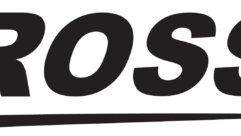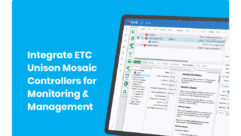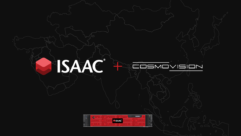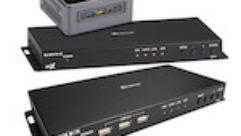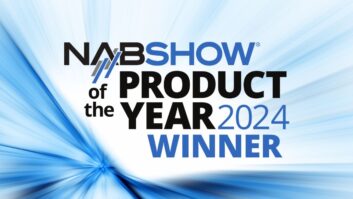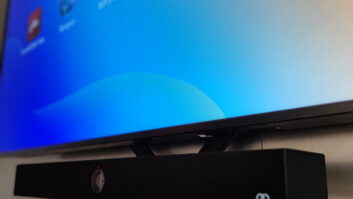A unified theme
Oct 1, 1998 12:00 PM,
Joshua Weisberg
The concept is simple-take your product on the road and show it to yourmost important clients in their own backyards. When the product happens tobe high-quality TV programming, however, it requires more than a TV set anda VHS tape to support the sales force. The solution comes in the form ofthe 1998 Discovery Communications Up-front sales tour, a unique challengefor producers and A-V professionals.
Building on the success of the Upfront tour of 1997 (the first timeDiscovery Communications took its sales show directly to ad agencyclients), the 1998 tour was slated to be more elaborate in design andexecution. The goal was to transform each and every meeting locationcompletely into a Discovery-themed environment through the use of video,sound, lighting and graphics. This goal would have to be met within thelimitations of a two-hour setup window, and because its ultimate test wasto come in front of potential clients, it had to run flawlessly.
Building on the previous yearOne major advantage right from the start was the inclusion of all theindividuals who had worked on the tour in previous years. The team includedAndy Holtzman, Gil Cowley and Michael Pasqualina from Discovery, JimDePalma of James DePalma Productions, Scharff Weisberg andMorrison/Merenstein (M/M). The Discovery group supplied direction and videomaterial; Jim DePalma managed the production; Scharff Weisberg furnishedthe system design and all of the hardware, and M/M produced the computergraphics.
Upon initiation of the project, an immediate goal was to find ways toimprove on the previous tour. Although the approach used last year waseffective, the presentation did not change the meeting location in anysignificant way; it still looked like the client’s conference room.Therefore, any improvements would be used to create a sound, light and videoenvironment so distinctive that the attendees will feel as though they have leftthe building without physically moving farther than down the hall.
Video displaysAfter using various types of multi-scan monitors last year, it wassuggested that a more uniform approach be considered. The problems lie inthe fact that each meeting room is different in size. Some tend to be moreconducive to large displays, and some of the others cannot accommodateanything larger than a 26 inch (655 mm) monitor. The ideal solution came inthe form of the new plasma-based flat display technology. Using thesedevices, it was possible to use a 40 inch (1 m) monitor in any of the roomsvisited and not have to worry about an excessively large footprint.
Eliminating the 16:9 aspect ratio units from consideration because thenative format for the video material is 4:3, the Pioneer PDP-V401was chosenfor its image quality, 4 inch (101 mm) depth and availability. The 10 unitspurchased for the tour were among the first units shipped to the UnitedStates, and they more than met the expectations. Image quality was moresuperior than expected, and the state-of-the-art nature of the technologyfit in perfectly with Discovery Communications’ corporate image as theleader in informative, progressive TV programming.
Because the presentation is designed to use computer graphics as well asvideo, the video system incorporated Extron Emotia scan converters to dropthe director graphics from 800 X 600 resolution to NTSC. This allowedsmooth cross-fades from video to graphics and back through a simplePana-sonic switcher. Everyone was generally pleased with the way the systemdisplayed Discovery’s video promos and graphics.
To announce Discovery’s presence on the site (usually an ad agency office),banners would be placed in the office lobby. For 1998, Discovery alsodesigned a vertical metal structure to hold six small video monitors.Dubbed the video tree, this display rolled a video attract loop as apreview to the presentation.
AudioThe major enhancement to the audio system was the addition of a poweredsubwoofer to augment the Apogee AE-3s and JBL Control 8s that made up theloudspeaker array. The objective was to find a subwoofer that would bepowerful but small because space is always at a premium. Looking into theworld of high-end hi-fi, the Sunfire sub was chosen. Adding just one ofthese to the system gave the extra punch required and was particularlyeffective for the thunder-and-lightning videos featured in Discovery’spresentation. Although the video and visual graphics were stunning, theproduction would have fallen somewhat short without an adequate sounddelivery system.
LightingPerhaps the greatest room for improvement could be found in the lightingsystem, which was, at best, rudimentary last year. The team felt an idealsystem would incorporate moving light instruments for flexibility andpizzazz. The question was, would it be possible to find units small enoughand reliable enough to use on the tour? The answer was found in the IrideonAR-5, a small moving light fixture designed for architectural usage andsupplied by Production Arts Lighting. The AR-5’s color, movement and irischanges were stored in a Maris DMX recorder, which was triggered by the AMXsystem controller. In addition to the moving light instruments, patternprojectors were used to project starfields and clouds, and a couple of 3.5inch (88 mm) lekos were used to light the custom-built podium.
The executionOnce all the components had been agreed upon, the system had to beassembled in a way that would promote quick and easy setup. This wasaccomplished by using pre-wired aluminum truss uprights to hold themonitors, loudspeakers and lighting. The trusses had a sleek techno lookand were relatively easy to move in and out of the offices where thepresentations took place.
Power capacity, or the lack of it, was somewhat of a concern because theentire system would require at least 40 amps, which is not to be found inall conference rooms. The low-tech, but practical, solution was to run longextension cable to adjacent offices and use some artful negotiation tacticswith the local office staff. (You don’t need this computer plugged in forthe next two hours, do you?)
Finally, once all the components had been assembled and tested, the systemwas programmed to run off a simple AMX button pad. At the press of abutton, lighting changed color and dimmed, video and audio would roll andthen return to computer graphics at the end of the video roll.
The resultImagine entering your conference room for yet another stultifyingpresentation only to find it pulsing with light, sound and images. Imaginea presentation packed with the latest technology harmoniously blended tobring vibrant TV programming to life. Imagine a seamless presentation givenby executives who are enthusiastic about what they are presenting and thetools they have to work with. If you can imagine this, then you have a goodidea of what Discovery Upfront 1998 was like.
Two months, 10 cities, 48 presentations and not a single misstep along theway. Perhaps the best gauge of success was the number of times audiencesactually applauded during the presentations. In this day and age, that isnot exactly a frequent occurrence during a sales call.



